Objects : 24
-
 Object / Directoire-Consulat-Ier Empire/Directory-Consulate-1st EmpireA ceremonial inkstand for Napoleon’s “Grand Cabinet” at the Palais des Tuileries
Object / Directoire-Consulat-Ier Empire/Directory-Consulate-1st EmpireA ceremonial inkstand for Napoleon’s “Grand Cabinet” at the Palais des TuileriesThis luxurious inkstand (GMLC-624-000) (which before 2021 had never been publicly exhibited) was made for the Grand Cabinet (formal office) of Napoleon I at the Palais des Tuileries by Martin Guillaume Biennais (1764-1843) and delivered there in December 1813. At the same time, the Emperor’s goldsmith supplied an identical copy for the palace of Fontainebleau(exhibited at the exhibition […]
-
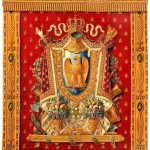 ObjectThe Great French Imperial Coat of Arms, door hanging for the Emperor’s “grand cabinet” at the Palais des TuileriesThe “grand cabinet” of his “grand appartement de représentation” [great reception apartment] was, in Napoleon’s eyes, the most important room in the Tuileries Palace. It was here that he held the Council of Ministers and received the oaths of the dignitaries and great officers of…
ObjectThe Great French Imperial Coat of Arms, door hanging for the Emperor’s “grand cabinet” at the Palais des TuileriesThe “grand cabinet” of his “grand appartement de représentation” [great reception apartment] was, in Napoleon’s eyes, the most important room in the Tuileries Palace. It was here that he held the Council of Ministers and received the oaths of the dignitaries and great officers of… -
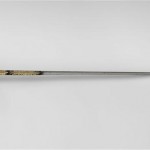 Object / Directoire-Consulat-Ier Empire/Directory-Consulate-1st EmpireNapoleon I’s Coronation SwordWhen Bonaparte became First Consul, head of state, he wanted a ceremonial weapon for grand state occasions, based on the example of the very lavish sword made in 1784 for Louis XVI. He specified that it should “be in keeping with the customs related to…
Object / Directoire-Consulat-Ier Empire/Directory-Consulate-1st EmpireNapoleon I’s Coronation SwordWhen Bonaparte became First Consul, head of state, he wanted a ceremonial weapon for grand state occasions, based on the example of the very lavish sword made in 1784 for Louis XVI. He specified that it should “be in keeping with the customs related to… -
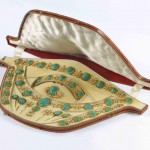 Object / Directory / 1st EmpireMalachite Jewellery Ensemble supposedly belonging to Josephine
Object / Directory / 1st EmpireMalachite Jewellery Ensemble supposedly belonging to JosephineThis ensemble of two necklaces, a pair of bracelets, a diadem, a brooch, a pendant and six pins, attributed to jewellers Marie-Étienne Nitot and François-Régnault Nitot (father and son), is decorated with cameos in malachite, natural pearls, yellow gold and tortoiseshell. All except three of the cameos have antique-style figures on them, female or male profiles. The two […]
-
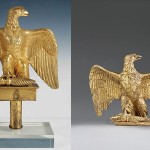 ObjectThe Imperial Eagles of the First and Second Empires
ObjectThe Imperial Eagles of the First and Second EmpiresIn the decree of 10 July 1804, Napoleon I stipulated that the new imperial coat of arms should be “d’azur à l’aigle à l’antique d’or, empiétant un foudre du même” (“azure, with an eagle in the manner of antiquity, coloured gold, clutching in its talons a thunderbolt of the same colour”). After the proclamation of […]
-
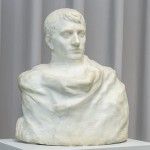 ObjectNapoleon wrapped in his dream
ObjectNapoleon wrapped in his dreamThis posthumous portrait of Napoleon Bonaparte carved in marble must be one of the most curious works to come out of the studio of French sculptor Auguste Rodin. It was commissioned in 1904 by the American collector Kate Seney Simpson,The daughter of a Brooklyn banker and art collector, George I. Seney and wife of New […]
-
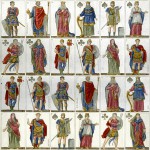 ObjectPrototype for a set of Imperial Playing Cards
ObjectPrototype for a set of Imperial Playing CardsClick here for an enlargement The first playing cards appeared in Europe at the beginning of the 14th century. However, even as late as the 18th century, they were by no means unified in their style. In France, the pack comprised the four classic suits – spades, diamonds, hearts and clubs (the French word trèfle […]
-
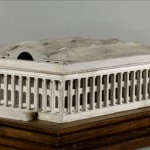 ObjectScale-model for Brongniard’s Palais de la Bourse
ObjectScale-model for Brongniard’s Palais de la BourseThe Palais Impérial de la Bourse (Imperial Palace of the Stock Exchange) was conceived by Napoleon as part of a wider political and architectural program. Upon his coming to power with the coup of 18 Brumaire, Napoleon was determined to rebuild the political institutions of France which had for a decade been shaken by Revolution. […]
-
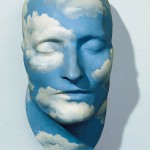 ObjectThe Future of Statues
ObjectThe Future of StatuesMagritte made four versions of this work, “L’Avenir des statues” (‘The Future of Statues’), in the period 1933 to 1937. He took a commercial plaster version of Napoleon’s death mask and painted onto it a deep-blue sky spotted with sunlit clouds. According to David Sylvester, it is only the polish on the plaster and the […]
-
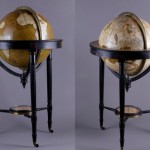 ObjectNapoleon’s terrestrial and celestial globes from Longwood
ObjectNapoleon’s terrestrial and celestial globes from LongwoodBoth globes had been part of the furniture at Plantation House since 1805. In July 1816, the Governor Sir Hudson Lowe had them sent to Longwood House where they were installed in the parlour also known as the billiard room. Virtually all the witnesses of the exile mentioned in their writings these “two globes, one […]

